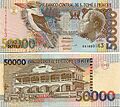São Tomé and Príncipe dobra facts for kids
Quick facts for kids São Tomé and Príncipe dobra |
|||
|---|---|---|---|
|
|||
| ISO 4217 Code | STN | ||
| User(s) | |||
| Inflation | 5.0% | ||
| Source | July 2015 | ||
| Pegged with | euro = 24.50 STN | ||
| Subunit | |||
| 1⁄100 | cêntimo | ||
| Symbol | Db | ||
| Coins | 10, 20, and 50 cêntimos; 1 and 2 dobras | ||
| Banknotes | 5, 10, 20, 50, 100, 200 dobras | ||
The dobra (pronounced "DOH-bra") is the official money, or currency, used in the island nation of São Tomé and Príncipe. It is shortened to Db and is split into 100 smaller units called cêntimos. The first dobra (known as STD) was created in 1977. It took the place of the old escudo money, with one dobra being worth one escudo.
Because prices in the country went up a lot over time (this is called inflation), the dobra was changed on January 1, 2018. This change meant that 1,000 old dobras became 1 new dobra. The new dobra was given a new code: STN.
São Tomé and Príncipe made a deal with Portugal in 2009 to link the dobra to the euro. This means the exchange rate between the dobra and the euro is fixed. From January 1, 2010, 1 euro was equal to 24,500 old dobras. For the new dobra, 1 euro is equal to 24.5 new dobras.
The name "dobra" comes from a Portuguese word that means "doubloon," which was an old gold coin.
Contents
Coins of São Tomé and Príncipe
The First Dobra Coins (Before 2018)
In 1977, the first coins were made. These included values of 50 cêntimos, and 1, 2, 5, 10, and 20 dobras. Most of these coins were made from a mix of copper and nickel. A 50 dobra coin was added in 1990. These coins showed pictures of local food, plants, and animals. Even though you don't see these coins much anymore because prices went up, they can still be used as money.
In 1997, a new set of coins with higher values was made. These were 100, 250, 500, 1000, and 2000 dobras. The 100 and 250 dobra coins were round. The 500, 1000, and 2000 dobra coins had a special seven-sided shape. All these coins were made of steel with a nickel coating and showed pictures of local wildlife.
On one side, all the coins have the country's coat of arms. On the other side, they say "Aumentemos a Produção" (which means "Let's Increase Production") and show the coin's value.
The New Dobra Coins (From 2018)
When the dobra was changed in 2018, new coins were made. These new coins are for 10, 20, and 50 cêntimos, and for 1 and 2 dobras.
Banknotes of São Tomé and Príncipe
The First Dobra Banknotes (Before 2018)
On September 30, 1977, the Banco Nacional de São Tomé e Príncipe (the National Bank) released banknotes for 50, 100, 500, and 1000 dobras. In 1996, even higher value notes were made: 5,000, 10,000, 20,000, and 50,000 dobras. The smaller value notes from the first series were replaced by coins in 1997. In 2006, new versions of these banknotes were released with better safety features to prevent fake money.
In December 2008, a 100,000 dobra note was added. This was needed because prices kept going up. This new note was quickly accepted by everyone.
Most of these banknotes show a picture of Rei Amador, a famous historical figure, on one side. However, the 100,000 dobra note has a picture of Francisco José Tenreiro.
The New Dobra Banknotes (From 2018)
New banknotes were released in 2018 when the dobra was changed. These notes are for 5, 10, 20, 50, 100, and 200 dobras. The 5 and 10 dobra notes were first printed on a special plastic material called polymer. All the banknotes feature different kinds of butterflies on one side and local wildlife on the other.
In 2020, the Central Bank released an updated version of the 200 dobra banknote. This was because the paper quality of the first version was not good. Also, the 5 and 10 dobra notes went back to being printed on paper. The plastic versions didn't work well in the hot, wet climate of São Tomé and Príncipe.
Why the Dobra is Linked to the Euro
In July 2009, the government of São Tomé and Príncipe signed an agreement with Portugal. Portugal used to rule São Tomé and Príncipe. This agreement was made to connect the dobra to the euro. Portugal agreed to provide up to 25 million euros to help with this. The European Commission also supported this plan. São Tomé and Príncipe believed that linking their money to the euro would make their country's economy more stable. They also hoped it would encourage other countries to invest money there.
Officials worked for a year to agree on this deal, which started in January 2010. A similar agreement was made ten years earlier between Portugal and Cape Verde.
Why the Dobra Changed (Redenomination)
On August 25, 2017, the Central Bank of São Tomé and Príncipe announced a big change to the dobra. This change was to celebrate the Central Bank's 25th birthday. They decided that 1 new dobra would be worth 1,000 of the old dobras.
Six new banknotes (5, 10, 20, 50, 100, and 200 new dobras) and five new coins (10, 20, and 50 cêntimos, and 1 and 2 new dobras) were released on January 1, 2018. For a while, both the old and new money could be used at the same time, until June 30, 2018. After that, you could exchange the old money at banks until December 31, 2018, and at the Central Bank until December 31, 2019.
See also
- Economy of São Tomé and Príncipe
- Currencies related to the euro
Images for kids



